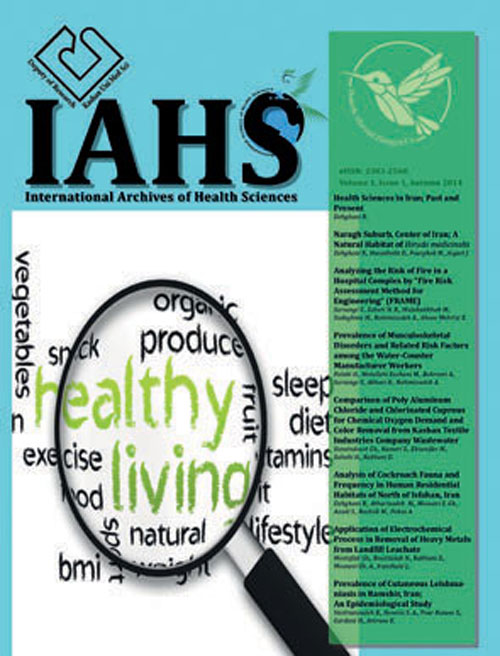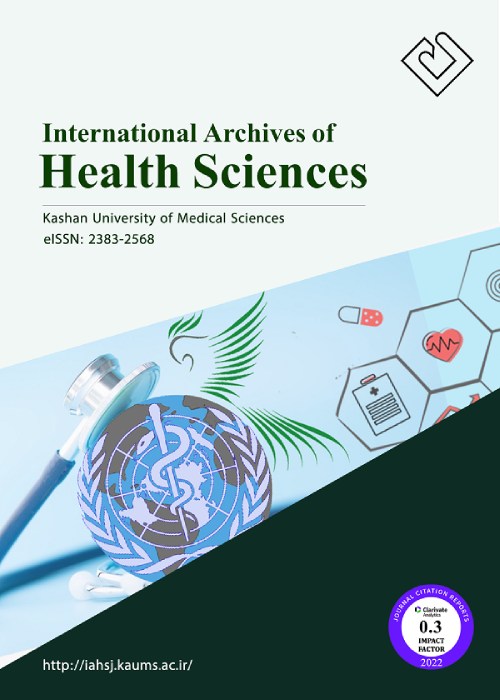فهرست مطالب

International Archives of Health Sciences
Volume:2 Issue: 3, Jul-Sep 2015
- تاریخ انتشار: 1394/06/25
- تعداد عناوین: 8
-
-
Pages 95-100AimsTehran’s uncontrolled expansion, which promoted housing, public utilities, industries and increase of vehicles caused the problem of air pollution. Necessary information about air quality in different places and different times is the first step of combating the air pollution. The purpose of this study was to investigate the annual, monthly and hourly average of 5 criteria air pollutants (PM10, O3, NO2, SO2, CO) of Tehran City, Iran.Instrument &MethodsThe hourly concentrations of PM10, O3, NO2, SO2, CO were obtained from 21 air quality-measuring stations of Tehran City, Iran, during April 2012 to March 2013. Data were presented by descriptive statistics in the form of mean and standard deviation.FindingsCO concentration was not changed during the period of study. Nitrogen dioxide increased in spring and winter. Sulfur dioxide was not changed in the first six months of the year but its concentration increased in winter. Trend of changes of floating particles showed increasing the concentration of this pollutant in May 2012 and January 2013. Ozone concentration increased in the warm seasons and decreased in the cold seasons.ConclusionPM10, O3, NO2, SO2 and CO has high concentrations and cold periods of the year are more polluted than the warm periods in Tehran City, Iran.Keywords: Air Pollution, Ozone, Carbon Monoxide, Nitrogen Dioxide, Sulfur Dioxide, Tehran
-
Pages 101-106AimsIn the past few decades, more attention has been paid to clean up soils polluted with heavy metals by plants. A serious problem in this way is the amount of heavy metals uptake by plants. This study was conducted to evaluate the effectiveness of 3 local plants of Mazandaran province, Iran, in reducing and controlling the soil’s heavy metals.Instrument &MethodsThe removal amount of three heavy metals (lead, zinc and cadmium) by native plants (maize, velvetleaf and wild amaranth) was investigated in alkaline (pH=8) and acidic (pH=5) soils and also using three substances such as EDTA, ammonium citrate and phosphate. The concentrations of these metals in leachate were measured by using atomic absorption spectrometry method.FindingsLead, cadmium and zinc levels in leachate in treatments with plants were less than unplanted ones. The concentrations of these metals in the produced leachate of treatments with acidic soils were higher than those with alkaline soils. In the treatments of soil polluted with additives, treatments containing ammonium phosphate and EDTA had the lowest and highest concentrations of heavy metals, respectively. Concentrations of these metals in treatments without plants were higher than those with plants.ConclusionIncreasing of soil pH is effective on stabilization of heavy metals in soil. Ammonium phosphate plays an important role in stabilizing and EDTA and ammonium citrate increase the mobility of lead, zinc and cadmium in soil and groundwater.Keywords: Metals Heavy, Soil, Plants, Water Pollutants Chemical
-
Pages 107-113AimsThe dramatic increase of smoking in adolescents has become one of the major challenges in most countries and it needs further consideration. The aim of this study was to determine the smoking prevalence and some related factors among high school students.Instrument &MethodsThis descriptive, cross-sectional study was done in 2012-13 academic year in male and female high school students of Kashan City, Iran and 328 students were selected by multi-stage random cluster sampling method. Data were collected by a researcher-made questionnaire which had three parts; demographic data, history of smoking in the family, and ways of smoking. Data analysis was done using Chi-square and ANOVA tests.Findings19.3% (52 students) of the high school students of Kashan City, Iran, were smokers; 41 boys (20.2%) and 11 girls (8.8%). Smoking had significant relations with sex, grade and having a smoker in the family. 30.3% of the students had a cigarette smoker and 32.40% had a hookah smoker in their family. Hookah was the most prevalent tobacco product. Friends (47.8% in boys and 10.4% in girls) and then relatives (13.4% in boys and 8.2% in girls) contributed to students’ smoking.ConclusionSmoking hookah and cigarette have a high prevalence in sophomore and junior high school boys and having a smoker family member or friend is a main risk factor of start smoking in adolescents.Keywords: Prevalence, Smoking, Students, Risk Factors, Iran
-
Pages 115-120AimsIn biological wastewater treatment processes, a large amount of sludge is produced. Stabilization of sludge is essential before disposal because of the risks to human health and environment. Therefore, selecting an appropriate process for stabilization this sludge may efficiently decrease risks. The aim of this study was to examine the compound efficiency of the advanced Fenton and ozonation oxidation processes in stabilization of biological sludge.Instrument &MethodsThis experimental study was conducted on raw sludge taken from Kashan University of Medical Sciences’ Wastewater Treatment Plant in Iran during 2014. Fenton and ozonation oxidation processes were used for sludge stabilization. H2O2 and Fe2+ concentration, along with their mutual interaction, were measured using repeated measures model. Then the effects of pH and time reaction on reduction efficiency of volatile solids (VS) were examined.FindingsThe maximum removal efficiencies in Fenton process at pH=3 and in ozonation process in pH=7 were obtained 85.1% and 92.9%, respectively. By increasing the reaction time from 30 to 90min, VS reduction efficiency in Fenton and ozonation processes increased and then reduced after 60min. The maximum reduction efficiencies of VS were obtained at 3000mg/l H2O2 concentration, So that the optimum ratio of Fe2+/H2O2 for sludge stabilization was 1000/3000mg/l with the efficiency of 91.5%.ConclusionOzonation process efficiency in stabilizing biological wastewater sludge is higher than that of Fenton process.Keywords: Waste Water, Sewage, Fenton\'s Reagent, Ozonation
-
Pages 121-124AimsUsing the best assessment methods is an important factor in educational development of health students. Modified essay questions and multiple choice questions are two prevalent methods of assessing the students. The aim of this study was to compare two methods of modified essay questions and multiple choice questions in occupational health engineering and work laws courses.Materials and MethodsThis semi-experimental study was performed during 2013 to 2014 on occupational health students of Mashhad University of Medical Sciences. The class of occupational health and work laws course in 2013 was considered as group A and the class of 2014 as group B. Each group had 50 students. The group A students were assessed by modified essay questions method and the group B by multiple choice questions method. Data were analyzed in SPSS 16 software by paired T test and odd’s ratio.FindingsThe mean grade of occupational health and work laws course was 18.68±0.91 in group A (modified essay questions) and was 18.78±0.86 in group B (multiple choice questions) which was not significantly different (t=-0.41; p=0.684). The mean grade of chemical chapter (p<0.001) in occupational health engineering and harmful work law (p<0.001) and other (p=0.015) chapters in work laws were significantly different between two groups.ConclusionModified essay questions and multiple choice questions methods have nearly the same student assessing value for the occupational health engineering and work laws course.Keywords: Examination Questions, Occupational health, Legislation as Topic
-
Pages 125-128AimsBottled water is widely used in many countries and more than 100 different brands of bottled water are produced in Iran. The aim of the present research was to assess the chemical compound of some Iranian brands of bottled water and compare them with the mention information on their labels. Instrument &MethodsThis descriptive study was performed during March to December 2012 on the 16 brands of bottled water produced in Iran. Random sampling (10 samples for each brand) was done by buying 1.5liter bottled water with different brands from the supermarkets in Kashan City, Iran. The concentration of Na+, K+, F-, NO3-, SO4-2 and Cl- and the pH of bottled water samples were measured. Data were analyzed by SPSS 16 software using independent T test.FindingsThe mean concentration of NO3- was 1.70±2.52mg/l, Na+ was 8.44±8.76mg/l, K+ was 0.11±0.53mg/l, SO4-2 was 15.15±12.49mg/l, Cl- was 42.30±33.84mg/l and F- was 1.02±1.88mg/l in all samples of 16 brands of bottled water. The highest concentration of NO3- was seen in brand 12 (9.55±2.76mg/l), Na+ in brand 6 (32.18±12.60mg/l), K+ in brand 13 and 4 (1.86±0.76mg/l), SO4-2 in brand 6 (40.53±8.90mg/l), Cl- in brand 16 (88.73±13.80mg/l), F- in brand 13 (0.63±0.12mg/l). The pH of brand 12 (7.9±0.1) was the highest among the samples.ConclusionThe concentrations of Na+, K+, F-, NO3-, SO4-2 and Cl- of the studied Iranian brands of bottled water are not higher than the national and international standards and the pH is in the acceptable range.Keywords: Bottled Water, Drinking Water, Water Quality, Public Health
-
Pages 129-132AimsInfection with parapoxvirus is an occupational hazard of farm workers, abattoir workers, veterinarians, and others with frequent exposure to sheep, cattle, or goats. The aim of this study was to determine the risk working groups in Kashan City, Iran.Patients &MethodsThis case series study was performed in the private clinic of Dr. Afzali in Kashan region, Iran during 2000-13. Diagnosis was made by history, appearance and location of the lesion and clinical course through pathological examination of all patients by an expert physician. The history of contact with sheep or goats, duration of the prodromal period, the location of the lesions, the patient’s dominant extremity, duration of recovery, complications, clinical symptoms, profession, age and sex were recorded. Data were entered into SPSS 16 software and were presented by descriptive statistics.Findings11 patients with Orf disease were recognized during the study period, 8 of which were male. The mean age of all samples was 33.1±15.3 (12 to 64) years. The mean of incubation period was 11.7±6.4 (5 to 19) days. The mean of lesions resolution was 24.8±8.5 (14 to 42) days. All cases resulted in healing without any complications.ConclusionThe most important risk groups in our study were abattoir workers, butchers, housewives and students who handle infected animals.Keywords: Humans, Orf Virus, Parapoxvirus
-
Pages 133-138AimsTextile industries are among the manufactures which produce the highly polluted waste water. The purpose of this research was to evaluate the effect of vermifiltration on COD and color removal from textile waste water.Materials and MethodsThis experimental research was performed March to August 2014 in one of the textile factories of Kashan region, Iran. The glass cubic kits with- without Eisenia fetida were used to filter the waste water samples. Data was analyzed using Kruskal–Wallis and two-way analysis of variance in SPSS 19 statistical software.FindingsThe mean of COD concentration in the raw waste water samples was 1324.24±757.01mg/l which was decreased to 598.22±349.33 and 831.32±445.19mg/l after the experimental and control kits usage, respectively (p<0.001). The mean of color intensity in raw waste water samples was 51.2±30.6% which was decreased to 27.8±15.0 and 27.4±15.1% (p=0.635) in experimental and control kits, respectively. There was a significant negative correlation between COD removal and hydraulic loads (p<0.001; r=-0.804) and a significant negative correlation between color removal and hydraulic loads (p<0.001; r=-0.278) in both experimental and control kits.ConclusionVermifiltration is an effective method for COD removal from textile waste water, while have not considerable effect on color removal.Keywords: Textile Industry, Waste Water, Oligochaeta, Color, Vermifiltration


